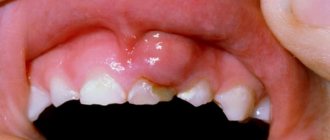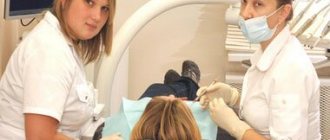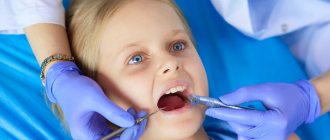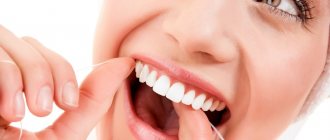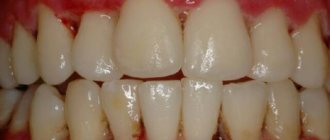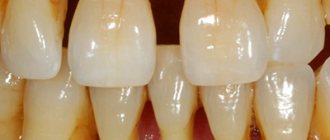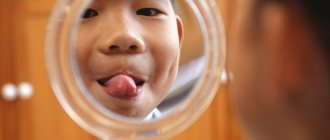From this article you will learn:
- what are gum diseases in children?
- gingivitis in children - symptoms,
- what to do if a child has an inflamed gum.
The article was written by a dentist with more than 19 years of experience.
Gingivitis in children is one of the most common diseases. However, gum disease in children is not limited to gingivitis. Inflammation of the gums in a child can also be observed with periodontitis of one of the teeth (in this case, an abscess or fistula appears on the gum). Also, the phenomena of gingivitis are always present against the background of a child’s illness with herpetic stomatitis.
Before starting treatment, it is very important to correctly differentiate gum disease in a child in order to avoid incorrect and thus useless treatment. Below we will look at each of these diseases separately.
Reasons for the development of gingivitis in children
The abundance of causes of the disease can be divided into two large groups.
Common reasons include:
- colds, especially if they occur frequently;
- sore throat and chronic sinusitis;
- hormonal disorders;
- gastrointestinal diseases.
Among the local reasons it is worth highlighting:
- poor-quality fillings, which, when destroyed, injure soft tissues;
- caries (infection from the cavity quickly enters the gums);
- crowded teeth;
- violations during the installation of braces;
- Tight lips that interfere with quality teeth cleaning.
Separately, it is worth noting the most important reason, since all of the above are only a catalyst for the development of the disease. So, the main reason why gingivitis begins to develop is poor oral hygiene, which can manifest itself both in improper brushing of teeth and in incorrectly selected toothpaste and brush.
Symptoms of the disease
Gingivitis has quite a few characteristic signs by which one can guess the onset of the disease:
- bleeding gums;
- pain during cleaning;
- swelling of the gums;
- severe redness of the gums in the case of an acute phase of inflammation;
- when the disease becomes chronic, the gums may acquire a bluish tint.
Often with the naked eye you can notice a large amount of accumulated plaque and tartar, and there may also be many teeth affected by caries.
In addition, gingivitis can be caused by diseases that have nothing to do with the oral cavity:
- heart and vascular diseases;
- disorders affecting the gastrointestinal tract;
- respiratory diseases.
The above factors reduce immunity, as a result of which the gums lose their ability to resist toxins formed in plaque.
What is the best way to treat?
As was said a little above, gingivitis occurs due to accumulated soft plaque, so the first thing you need to do is get rid of it. Plaque can be removed using ultrasound - this is a simple and absolutely painless procedure. Using a special attachment, the dentist touches dental plaque, which is destroyed by ultrasound. By the way, ultrasound allows you to get rid of not only soft plaque, but also hardened formations on the teeth.
It is necessary to understand that plaque can be effectively removed, especially if inflammation has begun, only with ultrasound: rinsing with various means, using special toothpastes and gels with the addition of antibiotics can temporarily remove the symptoms of gingivitis, but these methods are not able to eliminate its cause. As soon as you stop using these medications, bleeding will return and the disease will continue to progress. Therapy aimed at reducing the inflammatory process is justified only after the deposits have been removed.
Anti-inflammatory therapy is usually prescribed as follows:
- Rinse with Chlorhexidine solution. The maximum duration of use of the drug is 10 days. Rinsing should be done twice a day for at least 30-40 seconds per procedure. The solution, which has a bitter taste, which not all children will like, has no contraindications based on the child’s age.
- Rinse with Miramistin (prescribed after the child reaches the age of 3 years). You need to rinse three times a day. The drug is inferior in its effectiveness to Chlorhexidine and is significantly higher in price.
- Rinse with infusions of chamomile or sage (it is not recommended to use oak bark).
In addition to rinses, many doctors prescribe ointments and gels. It is believed that the gel is more effective than ointment because, due to its consistency, it has the ability to remain on the gums for a long time, which promotes better absorption. In addition, the medicinal substances contained in the product penetrate much better into the tissues from the gel than from the ointment.
The most effective and proven gels on the positive side are the following:
- Cholisal is a drug that simultaneously has two effects: analgesic and anti-inflammatory. It is used for gingivitis and the beginning of teething (the drug is rubbed directly into the place where the tooth is emerging). There are no age restrictions. The gel can be used for a maximum of one and a half weeks, twice a day. After applying the product, it is recommended to eat within two, or preferably three, hours.
- Metrogil Denta. Used after 6 years. Apply directly with your finger or a cotton swab to the gums near all teeth; there is no need to rinse off the gel.
Many parents often decide to treat their child on their own, not wanting to see a dentist. But you need to understand that the use of anti-inflammatory drugs will have no effect if you do not get rid of the deposits, so you will still have to set aside time to visit the dentist. If you ignore the advice, then:
- symptoms of bleeding will disappear, but will reappear after completion of the course of therapy;
- gingivitis can become chronic, causing periodontitis.
In addition to anti-inflammatory therapy, oral cavity sanitation and silvering are carried out - a method that does not require drilling, but has a lot of disadvantages.
How to avoid the occurrence of gingivitis?
The following remedies will help prevent gum bleeding:
- High-quality oral hygiene. Parents should instill in their children oral care skills from an early age. Not all adults know that hygiene measures must begin before the first tooth begins to erupt.
- Using the right paste. If the child does not have gingivitis, then you can use any paste designed for children. If your child does not brush their teeth well enough, you can purchase a paste with amino fluoride.
- Stick to your diet - avoid snacking, limit the consumption of fast carbohydrates (carbonated drinks, sweets). Of course, you don’t need to completely deprive your child of sweets, but you can give them only immediately after the main meal, after which you should brush your teeth.
Gingivitis in children: what are the causes and symptoms
Gingivitis, or inflammation of the mucous membrane around the teeth in children, is a fairly common phenomenon. Most often, gingivitis can be detected in a child aged 1–3 years, as well as in adolescence - in both cases, the “trigger” of the disease can be active growth of the body, hormonal changes and features of the formation of the immune system
Gingivitis in children develops quite quickly. If inflammation develops in a child’s mouth, the number of bacteria increases significantly compared to the norm. Within 72 hours, the process of stone formation from soft plaque begins, and the first signs of gum erosion appear. If the situation is neglected, this can lead to the loss of teeth in children - both milk and permanent.
Symptoms of gingivitis in children
How does gingivitis manifest itself in children? The symptoms are:
- bad breath
- discomfort, pain in the mouth
- bleeding gums
At the same time, the temperature with gingivitis in children does not always rise. Therefore, it is quite easy to miss the onset of the disease. A child may tolerate discomfort without attaching any importance to it, or endure it, fearing a visit to the dentist (especially if he has already had a bad experience with dental treatment). That is why it is necessary to unobtrusively check the oral health of your son or daughter from time to time. For kids this can be done during play, but for a teenager you will have to find a psychological approach. Perhaps it would be easier (and more correct!) to “introduce” your offspring to a professional dentist whom he can trust, and periodically take him for preventive examinations.
Types of gingivitis in children
Only a competent doctor can determine what form of gingivitis a child is suffering from and, accordingly, prescribe effective treatment that quickly relieves discomfort. The disease can manifest itself in different ways:
- Catarrhal gingivitis. Children aged 3–7 years are most often affected. It is accompanied by swelling of the tissues around the tooth, unpleasant taste in the mouth, pain when pressure is applied to the gums, the appearance of pink saliva, general malaise and tearfulness. This type of disease easily becomes chronic, when gingivitis occurs approximately twice a year, causes temporary inconvenience to the child and seems to go away on its own. In fact, each time the inflammatory process becomes more and more severe, hard dental deposits are formed, which can ultimately “develop” into periodontitis - a disease in which the bonds of the tooth with the surrounding tissues are destroyed, which leads to its loss.
- Hypertrophic gingivitis. Painful sensations in a child do not appear immediately. The area of the front teeth is most often affected - the gums swell, changing their color (up to purple-blue). Over time, the tissues grow, covering a significant part of the tooth area, gum pockets appear, pus begins to be released, and severe pain appears.
- Atrophic ginivitis. This form of gingivitis is characterized by “recession” of the gums: the neck (and sometimes even the root) of the tooth is exposed, the child feels discomfort from eating cold and hot food. In this case, the gums become pale and bleed slightly. This is not only unpleasant and unsightly, but also quite dangerous and difficult to treat: you will most likely have to restore the shape of the gums using mini-plastic surgery.
- Ulcerative gingivitis. This is one of the options for the development of catarrhal gingivitis: the inflammatory process does not become chronic, but intensifies. Bleeding ulcers appear in the child's mouth, covered with a gray film - this is dead gum tissue. The child cannot eat and sleep normally, experiences severe pain, his body temperature rises to 39 °C... This development of the disease can be avoided by consulting a doctor at the first signs of gingivitis in the child.
Causes of gingivitis in children
Of course, parents want to believe that they will not have to treat gingivitis in children, knowing the causes of its occurrence. It’s really important to know them - they can be:
- Systemic diseases of the body (failure of the endocrine, cardiovascular, digestive, hormonal systems, the influence of infection)
- Dental pathologies, bite defects and errors in their correction
- Incorrect installation of fillings or their deformation
- Advanced caries, careless attitude of parents towards the health of the child’s teeth
- Weakened immunity, lack of vitamin C, poor appetite
But the main and main reason for the development of gingivitis in both children and adults still remains poor oral hygiene. Remember this the next time you allow your baby to “so be it, don’t brush his teeth just once”!
Expert opinion
There are many reasons for the development of gingivitis in a child, and not all of them are directly related to the condition of the oral cavity.
However, treatment should begin with a visit to the dentist: he will determine the form of the disease and prescribe the correct treatment, which will effectively relieve the symptoms - that is, quickly improve the child’s well-being. After all, sometimes inflammation of the gums causes real suffering to the baby, and he cannot even explain what is bothering him! A professional dentist will immediately understand what’s going on when he sees the clinical picture of the disease, and will definitely find an approach to the most capricious young patient. After this, parents (who will also immediately feel better after their child stops experiencing pain) should fully examine the child, starting with a clinical blood test.
Perhaps the inflammation is associated with teething, the formation of roots and the formation of a bite - this is the best option, it can be conditionally classified as normal. Otherwise, you will need to consult specialists from other medical specialties - you will need to look for and treat the cause of gingivitis.
Periodontitis and gum disease
Ignoring carious formations leads to the development of pulpitis, which turns into periodontitis. During periods of exacerbation of the disease, you may notice swelling of the gums, and cysts with purulent contents appear.
Diagnosis of gingivitis
The diagnosis should be made by a doctor in a dental clinic; only through a visual examination will he be able to determine the status of the disease and differentiate it from many others, which at an early stage may manifest the same symptoms.
The main clinical signs by which a dentist can make a diagnosis are:
- the presence of erythematous formations at the gum edge;
- looseness, separation of soft tissues from the dentition, the appearance of pockets larger than 3 mm;
- when pressed with a dental spatula, exudative and bloody discharge is observed, in some cases with a putrid odor;
- obtaining the result of smears to determine the pathogen.
The last point is one of the most important in making a diagnosis and prescribing adequate procedures. Depending on the type of bacteria that caused the disease, various antibiotics and antiseptics can be used to speed up recovery. Also, after collecting an anamnesis, based on diagnostic results, the doctor needs to identify the root cause in order to further prevent the risk of relapse.
Prevention of gingivitis –
WHO (World Health Organization) experts have identified the following main measures for the prevention of gingivitis:
- Proper oral hygiene –
firstly, it includes the correct technique for brushing the child’s teeth and gums, depending on age. After all, many parents simply don’t even know at what age they should start their child’s oral hygiene. And you need to start it even before the first teeth erupt. - Choosing the right toothpaste - secondly, toothpastes can provide significant assistance to parents in the fight against caries and gingivitis. If hygiene is of high quality, and as a result the child does not have caries and gingivitis, you can use almost any children’s toothpaste. However, in case of insufficient hygiene, toothpastes with special components (for example, amino fluoride) that can compensate for lack of hygiene to a certain extent can come to the rescue.
You can learn about how to choose the right toothpaste for a child, as well as read the ratings of such toothpastes, in the article: → “Rating of toothpastes for children of different ages”
- Balanced nutrition for children - we are talking about diet (avoid snacking) and limiting the intake of easily digestible carbohydrates (sweets, cookies, sweet drinks, etc.). Easily digestible carbohydrates should be given to the child only immediately after meals. After which you need to brush your teeth for 5 minutes.
